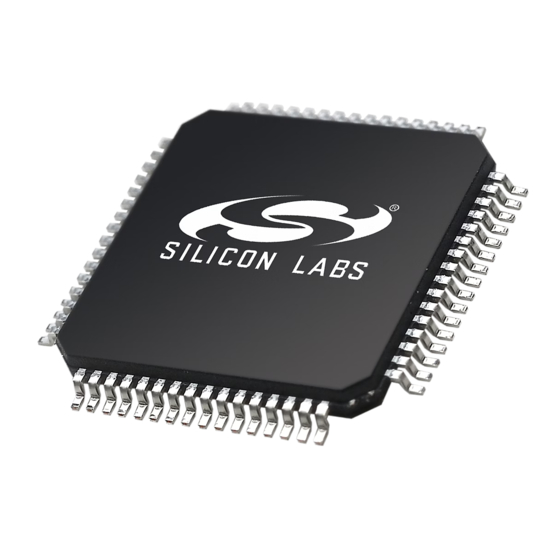
Advertisement
Quick Links
C 8 0 5 1 F 0 0
/ 0 1
X
1. Kit Contents
The C8051F00x/01x Development Kit contains the following items:
• C8051F005 Target Board
• C8051Fxxx Development Kit Quick-Start Guide
• Silicon Laboratories IDE and Product Information CD-ROM. CD content includes:
• Silicon Laboratories Integrated Development Environment (IDE)
• Keil Software 8051 Development Tools (macro assembler, linker, evaluation 'C' compiler)
• Source code examples and register definition files
• Documentation
• C8051F00x/01x Development Kit User's Guide (this document)
• AC to DC Power Adapter
• USB Debug Adapter (USB to Debug Interface)
• USB Cable
2. Hardware Setup using a USB Debug Adapter
The target board is connected to a PC running the Silicon Laboratories IDE via the USB Debug Adapter as shown
in Figure 1.
1. Connect the USB Debug Adapter to the JTAG connector on the target board with the 10-pin ribbon cable.
2. Connect one end of the USB cable to the USB connector on the USB Debug Adapter.
3. Connect the other end of the USB cable to a USB Port on the PC.
4. Connect the ac/dc power adapter to power jack P1 on the target board.
Notes:
• Use the Reset button in the IDE to reset the target when connected using a USB Debug Adapter.
• Remove power from the target board and the USB Debug Adapter before connecting or disconnecting the
ribbon cable from the target board. Connecting or disconnecting the cable when the devices have power can
damage the device and/or the USB Debug Adapter.
PC
Rev. 0.6 9/06
D
X
E VE L O P M E N T
USB
Cable
Figure 1.
Hardware Setup using a USB Debug Adapter
Copyright © 2006 by Silicon Laboratories
C 8 0 5 1 F 0 0 x / 0 1 x - D K
K
U
I T
S E R
AC/DC
Adapter
USB Debug Adapter
SILICON LABORATORIES
P1.6
Port 2
Port 1
'
G
S
UI D E
Target Board
PWR
MCU
Port 0
Port 3
Port 4
C8051F00x/01x-DK
Advertisement

Summary of Contents for Silicon Laboratories C8051F00x/01x-DK
- Page 1 • USB Cable 2. Hardware Setup using a USB Debug Adapter The target board is connected to a PC running the Silicon Laboratories IDE via the USB Debug Adapter as shown in Figure 1. 1. Connect the USB Debug Adapter to the JTAG connector on the target board with the 10-pin ribbon cable.
-
Page 2: Software Setup
ROM for additional information on using the Keil 8051 tools with the Silicon Laboratories IDE. To build an absolute object file using the Silicon Laboratories IDE project manager, you must first create a project. A project consists of a set of files, IDE configuration, debug views, and a target build configuration (list of files and tool configurations used as input to the assembler, compiler, and linker when building an output object file). - Page 3 C8051F00x/01x-DK 4.4.1. Creating a New Project 1. Select Project New Project to open a new project and reset all configuration settings to default. 2. Select File New File to open an editor window. Create your source file(s) and save the file(s) with a rec- ognized extension, such as .c, .h, or .asm, to enable color syntax highlighting.
-
Page 4: Example Source Code
C8051F00x/01x-DK 5. Example Source Code Example source code and register definition files are provided in the “SiLabs\MCU\Examples\C8051F0xx” directory during IDE installation. These files may be used as a template for code development. Example applications include a blinking LED example which configures the green LED on the target board to blink at a fixed rate. -
Page 5: Target Board
C8051F00x/01x-DK 6. Target Board The C8051F00x/01x Development Kit includes a target board with a C8051F005 device pre-installed for evaluation and preliminary software development. Numerous input/output (I/O) connections are provided to facilitate prototyp- ing using the target board. Refer to Figure 2 for the locations of the various I/O connectors. - Page 6 C8051F00x/01x-DK 6.1. System Clock Sources The C8051F005 device installed on the target board features a internal oscillator which is enabled as the system clock source on reset. After reset, the internal oscillator operates at a frequency of 2 MHz (±2%) by default but may be configured by software to operate at other frequencies.
- Page 7 C8051F00x/01x-DK 6.4. Analog I/O (J6, Terminal Block) An Analog I/O Configuration connector (J6) provides the ability to route analog I/O signals from the C8051F005 device to a terminal block by installing two shorting blocks on J6. It also allows the DAC outputs to be connected to Comparator 0 inputs or to two ADC inputs.
- Page 8 C8051F00x/01x-DK 6.5. Expansion I/O Connector (J2) The 64-pin expansion I/O connector J1 provides access to most signal pins of the C8051F005 device on the target board. A small through-hole prototyping area is also provided. All I/O signals routed to connector J2 are also routed to through-hole connection points between J2 and the prototyping area (see Figure 4 on page 9).
- Page 9 C8051F00x/01x-DK 7. Schematic Rev. 0.6...
- Page 10 C8051F00x/01x-DK OCUMENT HANGE Revision 0.4 to Revision 0.5 Section 1, added USB Debug Adapter and USB Cable. Section 2, changed name from "Hardware Setup" to "Hardware Setup using an EC2 Serial Adapter". Section 2, added 2 Notes bullets.
- Page 11 The products must not be used within any Life Support System without the specific written consent of Silicon Laboratories. A "Life Support System" is any product or system intended to support or sustain life and/or health, which, if it fails, can be reasonably expected to result in significant personal injury or death.
- Page 12 Mouser Electronics Authorized Distributor Click to View Pricing, Inventory, Delivery & Lifecycle Information: Silicon Laboratories C8051F005DK...

Need help?
Do you have a question about the C8051F00x/01x-DK and is the answer not in the manual?
Questions and answers